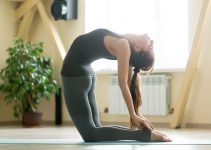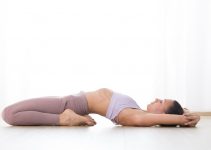- What It’s
- Benefits
- Rope Wall Poses
- Hand-to-big toe pose
- Side reclining leg lift
- Raised leg pose
- Rope headstand
- Revolved triangle
- Down dog
- Cobra pose
- Wheel pose
- Side angle pose
- Upward facing stretch
- Inverted child pose
- Revolved half moon
- Safety tips
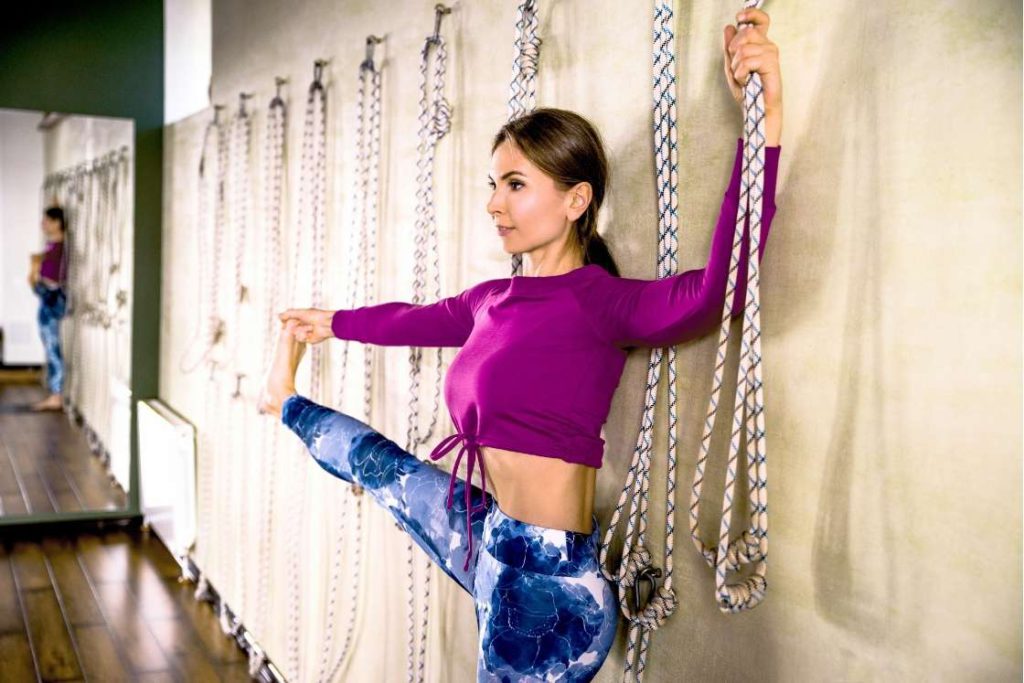
The rope hanging on the wall of a yoga class is one of the major attractions for beginners attending an Iyengar yoga class for the first time. Wall ropes are used as one of the essential yoga props to modify conventional yoga poses according to the needs of individuals.
Almost all yoga poses can be modified and performed easily using wall ropes. This diversity in the regime of yoga poses develops a new style of yoga called Rope Yoga.
What is Rope Wall Yoga?
Rope wall yoga is a methodology of Iyenger yoga to practice using rope suspended on a wall to achieve proper alignment, enhanced stretch, and longer duration in any pose. Yogacharya B.K.S Iyenger advanced this concept of rope wall yoga.
Rope yoga is also known as “Yoga Kurunta” (not Yoga Korunta, which is a text), where, “kurunta” is a Sanskrit term that refers to “puppet”. It is named so because using ropes to get into a yoga posture stretching, flexing, or, twisting the body resembles a puppet movement.
Trying rope yoga comes-in handy for beginners as well becomes it helps in stretching and opening the stiff muscles and deepens the practice.
All Iyengar yoga classes are equipped with rope walls in fixed configuration.
Installing the rope wall setup
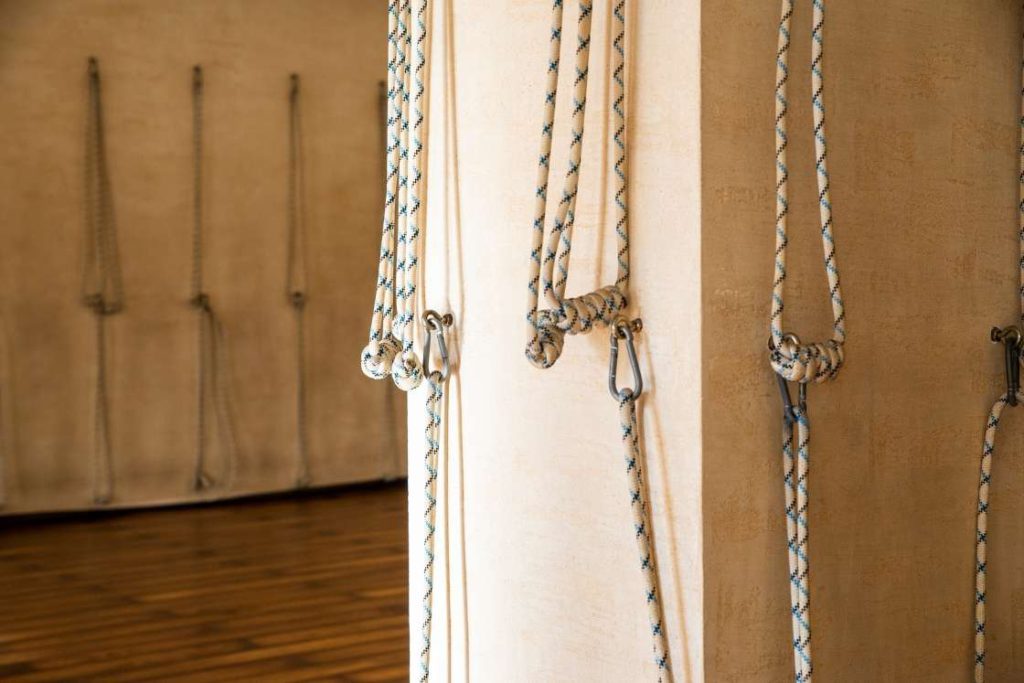
To practice rope yoga, the ropes or adjustable yoga straps are suspended to wall hooks to assist the practitioner in getting into any pose. Besides yoga straps and ropes, comfortable pelvic swings are also used for practitioners of different heights and body types.
The setup of rope yoga consists of four attachment points established on two different heights. To each attachment point, one sturdy rope is suspended.
There are three types of rope wall configurations in a typical Iyengar yoga class.
- Permanent wall configuration – In this configuration, ropes are suspended and secure to the rungs, eye-hook crews, or some other types of attachments drilled into a wall.
- Portable wall configuration – These are artificial wall setups that securely screwed into the permanent wall and are detachable in nature.
- Temporary rope wall configuration – There are some over-the-door attachment points available for establishing such kind of setup. It just requires a strong door where you can secure the slings that come along with this attachment. For low rope attachment points, the rope can be secured on the sturdy door handles.
Benefits of Rope Wall Yoga
Besides giving additional support to ease into any yoga pose, the following benefits of rope yoga are worth trying this practice.
- Rope yoga exercises enhances the body awareness and mobility working on even those joints that are usually left unaddressed. Thus, yogis utilize this practice as an aiding tool to experience proprioception.
- It helps achieve meditative states, as using ropes to enter a pose enhances the duration of holding a posture. This eventually gives more time for focused breathing while practicing yoga to reach higher consciousness.
- Rope yoga enables the practitioner to get into advanced poses which beginners or intermediate practitioners are skeptical to practice on the floor.
- Any injury or stiffness do not come in between your practice in rope yoga. Therefore, besides other benefits, its various therapeutic uses like are one of its kind.
- Practicing inversions like suspended headstand in rope yoga taking support at the back improves blood circulation in lower back and doesn’t even compress the crown of the head.
- Similarly, rope yoga is beneficial in improving the concentrating power and memory retention more than any usual practice.
- Another major benefit of rope yoga is invigoration of the muscles and improved balance of the body.
Rope Wall Yoga Poses to Try
Any traditional yoga asanas of hatha yoga when practiced in rope wall, considered rope wall poses of Iyengar yoga. Any beginner who’s lacking in flexibility can opt for these rope wall poses to get advantages of an advanced pose. However, one should always begin the practice under a certified Iyengar yoga teacher.
1. Extended hand-to-big toe rope wall pose
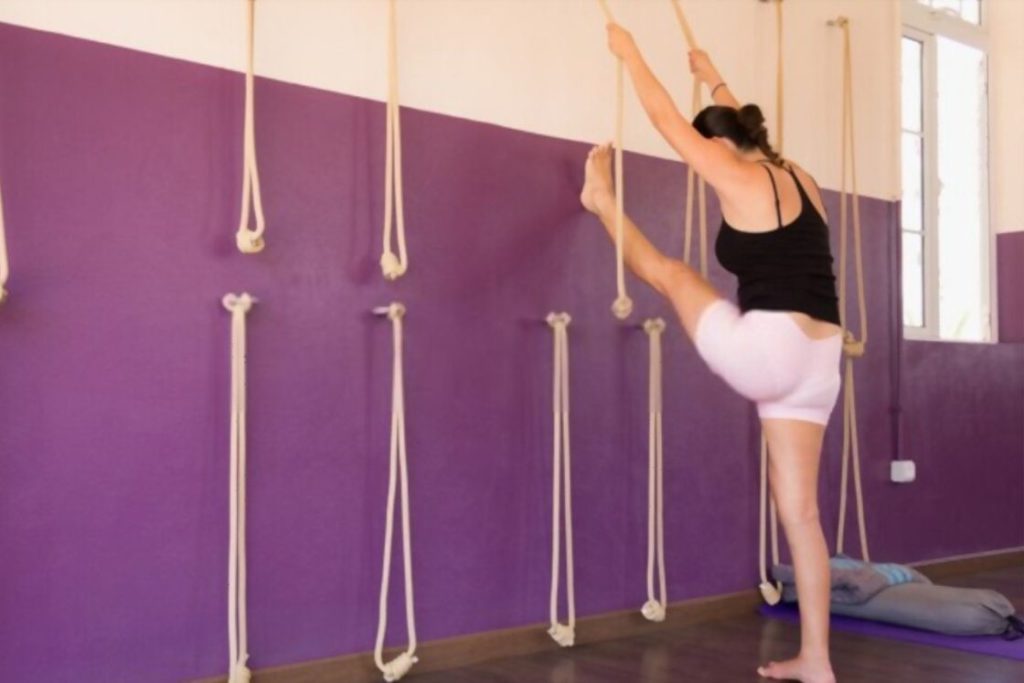
Extended hand-to-big toe pose is an intermediate level posture attained standing on one leg while lifting the other foot off the floor. In rope yoga, the pose is followed by placing the lifted heel over suspended strap hand and holding the ropes with both hands.
The conventional Extended hand-to-big toe pose is tricky for beginners due to tight hamstrings, lack of strength and, stability. Hence, practicing it with rope yoga improves flexibility of the legs, arms, and elongates the spine. This also enhances the balance of the body.
How to do
- Stand tall facing the wall with suspended ropes and ledge.
- Lift your right leg and place it over the ledge.
- The left leg remains firm on the floor with the left ankle stacked under the left hip.
- Extend both of your arms to hold the ropes suspended on the front wall.
- The left leg is kept straight with the foot pointing forward.
- Pull the ropes against the lifted leg lifting the chest and spine.
2. Side reclining rope leg lift
The conventional pose of this rope yoga exercise is Anantasana, also known as Sleeping Vishnu pose.
It Is practiced lying on the floor onto one side of the body with raised head and legs suspended on the ropes stacking the ankles horizontally over the floor. The other end of the rope holding the above foot is pulled with the hand to increase the pressure on the upper leg. With the rope wall, we can increase the opening between legs in this side reclining leg lift pose.
This pose is beneficial in enhancing hip mobility, strengthens the core, and also reshapes the bust line. It improves the blood circulation in the legs.
How to do
- Lie down on your back and turn onto your left side. Head is towards the rope wall and legs away from the wall.
- Raise your head and bend your left arm at the elbow so that the head rests over the palm.
- Place the right hand in front of the chest on the ground.
- Suspend both the legs onto two ropes wrapping the loops of the ropes around ankles. This rope would be attached to a hinge point on the wall whose one end will be on your right hand in front of your chest.
- Pull the other end of the rope holding the right foot with the right hand to raise the right leg.
- Raise and lower the right leg with rope and continue it for 2 minutes.
3. Raised leg Rope wall Pose
Just like legs up the wall pose, raised leg rope wall pose is performed with help of rope yoga mounted on a wall around a hinge point.
It is practiced reclining on the back on the floor and securing the rope around the ankles to raise the legs on the wall. The rope is further pulled by the hands to extend the legs perpendicular to the floor.
This is a calming restorative pose relaxing the mind and hence improves memory retention and ability to focus. This relaxing rope yoga pose is beneficial in resolving ENT issues and disorders like tinnitus.
How to do
- Lie down on your back placing the arms by the sides and legs extended in front with wall beside you.
- Bend your legs and loop the rope suspended on the wall around the ankles.
- Hold the other end of the rope with hand to pull the legs up until they become perpendicular to the floor
- Hold this position for a few minutes.
4. Rope Headstand
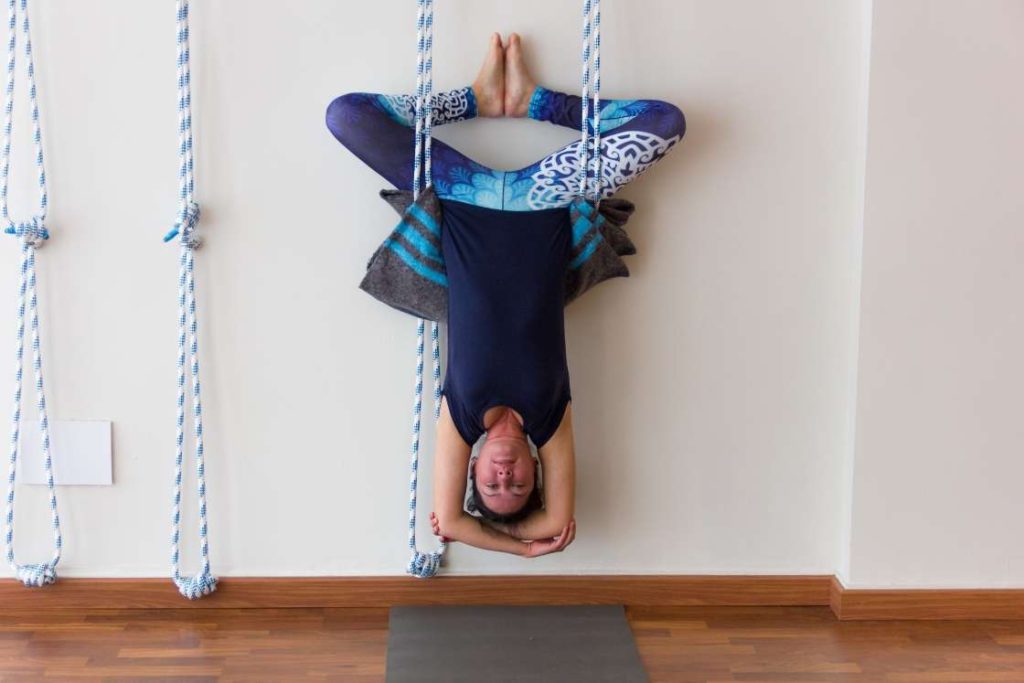
Headstand is one of the advanced poses that can be done easily in rope wall yoga by hanging down with the help wall ropes. It is practiced climbing in the wall pulling the ropes towards you and then sitting on the wall extending the legs in front while keeping the rope secured around the waist. It is followed by reclining on the wall until the head is lowered to the floor and hands lie on the floor.
Headstand is quite popular among rope yoga exercises, as using rope wall make it even more rejuvenating and increases the duration in this pose. It improves blood circulation to the brain and improves overall strength of the body.
How to do
- Get into the loop of the rope right above your hips while standing facing a wall and hold the rope with the hands.
- Pull the rope with the hands and start walking on the wall until the body becomes perpendicular to the wall.
- Bend your knees to lower the buttocks against the wall.
- Extend the legs in front and recline against the wall lowering the head towards the floor.
- The lower back remains supported by the rope.
- The arms can be left extended to the floor or overlapped over the head with alternate hands reaching the elbows.
5. Revolved triangle Rope wall pose
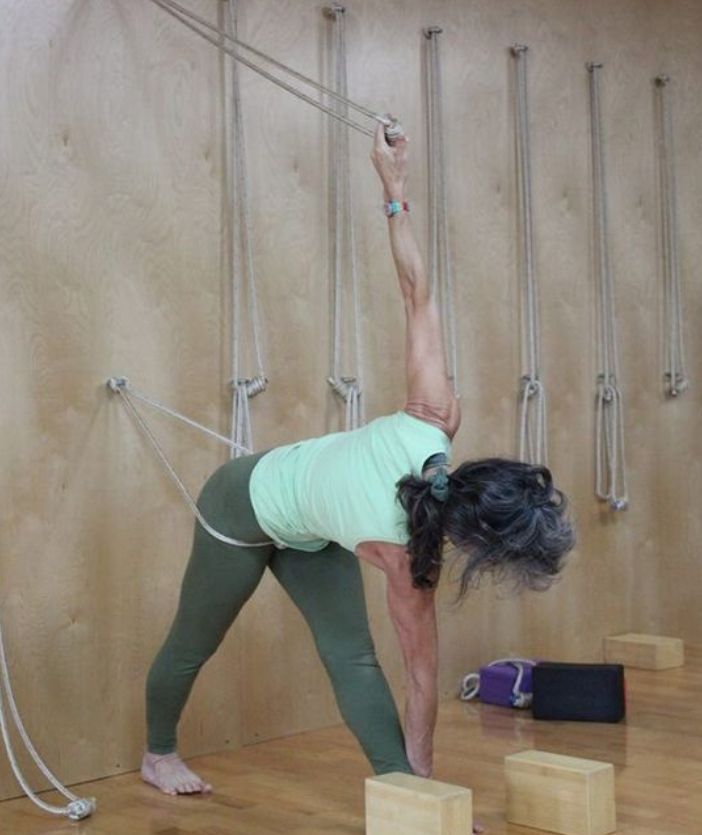
To come into the revolved triangle pose in rope wall yoga, stand near the wall with one foot pressed against the wall while the other is separated apart. open the arms with the hand near-wall holding the rope and this is further followed by bending the torso sideways pulling the rope until the hand away from the wall reaches the floor.
Performing reverse triangle pose with the help of rope increases the stretch improving the flexibility of legs, hips, and arms. It also stretches the abdominals improving digestion. This pose is also remedial for backache.
How to do
- Stand separating legs wide apart placing the outer edge of the left feet pressed against a wall.
- Hold the yoga rope hanging on the wall with the left hand above your height.
- Turn your right foot 90 degrees to the right and spread your right arm with fingertips pointing to the right.
- Sliding the left hand down to the rope’s lower end bend your torso towards the right leg with your right hand reaching the floor beside the right foot.
- Turn your head to look towards the left hand still holding the rope.
- Stay there for a couple of breaths and then get up to switch sides.
6. Downward dog rope wall pose
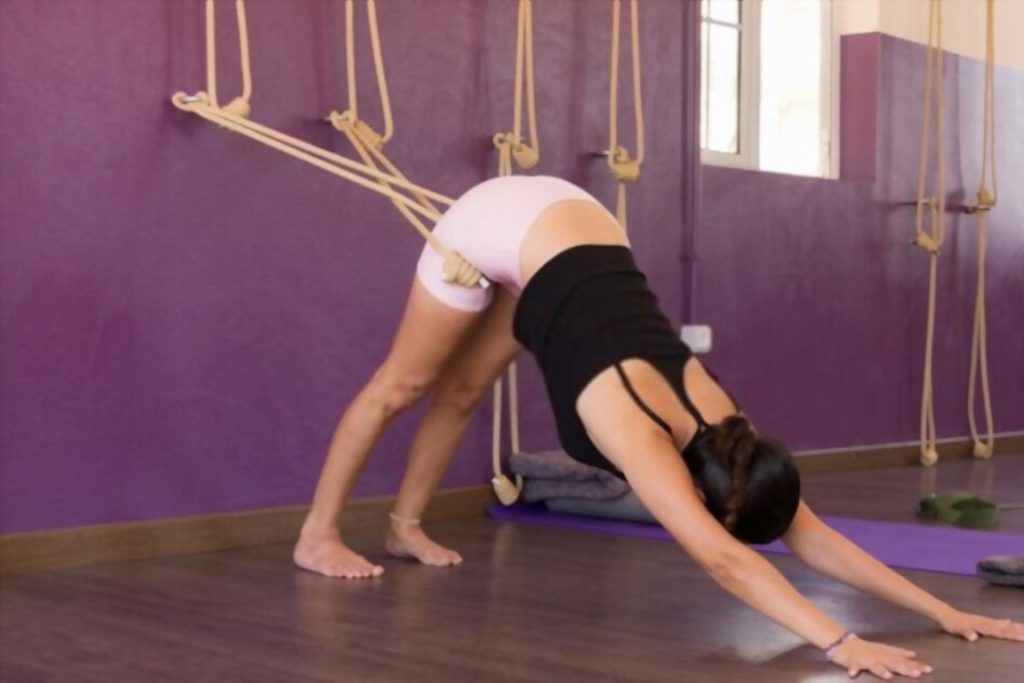
Down Dog in rope yoga is practiced by securing the waist with the rope while standing near the wall keeping the back towards the wall. From there bend the torso forward over the rope, bring the heels over the wall and lower your head to the floor. Extend your arms to reach the floor and stretch keeping the core engaged.
This pose with the help of rope yoga enhances the stretch and make it accessible to all practitioner with ease. The head, neck, and torso are inverted for as long as possible and strengthens the arms, back, core, and leg muscles. It also improves blood circulation and relieves stress.
How to do
- Stand tall with your back pressed against the wall and drawing the ledge of ropes in front of below your waist.
- Walk forward till the rope comes to your hip crease.
- Lean forward putting the body weight over the rope to reach the floor with the head.
- Hold the rope straps with hands and walk backward to lifted heels against the wall.
- Extend your arms straight on the floor beside your head with palms touching the floor.
- Look towards your navel and stay in this pose with long deep breaths creating space in the spine.
- You can also place a bolster under your head to keep the head and relaxed in this pose.
7. Cobra pose on rope wall
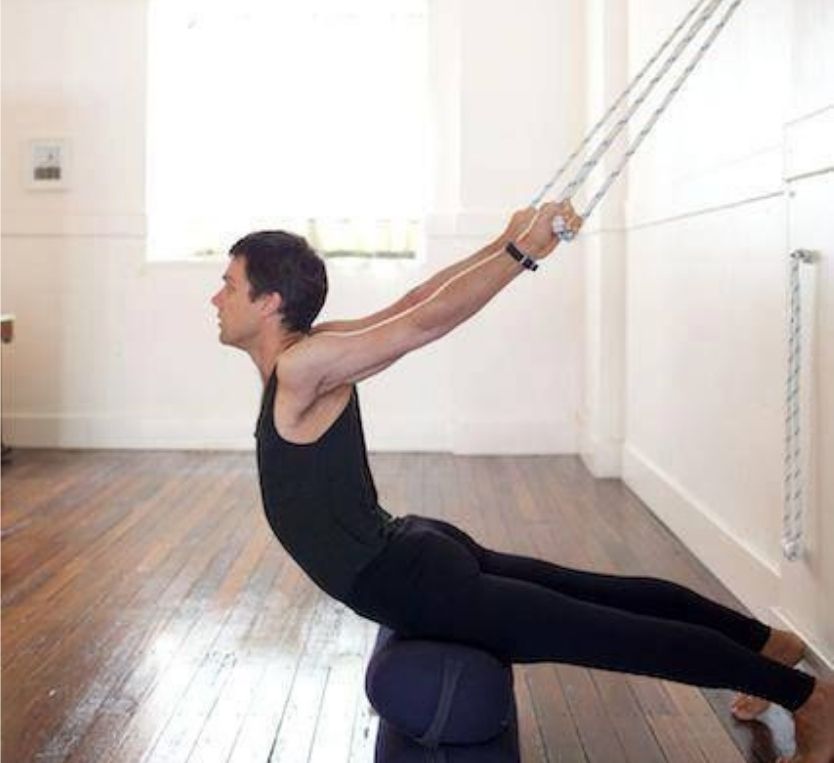
Rope wall yoga is considered best for backbend poses like bhujangasana (cobra pose).
For practicing cobra pose with ropes suspended on the wall stand between the ropes with back towards the wall. Hold the ropes bending the arms and start walking forward until arms get straight backwards. From there reach lean forward from the torso and take your heel to the wall with toes remaining on the floor. Pushing the hips to the floor open your chest holding the ropes with the hands arching the neck and lower back.
It enhances shoulder mobility to relieve frozen or stiffed shoulders. Patients of cervical spondylosis also experience neck pain relief. It stretches the abdominals, thereby relieving digestive issues.
How to do
- Stand tall with your back towards the wall between two ropes suspended on the wall.
- Drawing the arms backward hold the loops of suspended ropes with your hands.
- Walk forward until the arms become straight holding the loops.
- Fold forward at the hips halfway towards the floor and start to walk backwards towards the wall.
- As you reach back lift your heels against the wall only the toes remain on the floor.
- Pressing the heel against the wall to drop the buttocks towards the floor stretching the pelvis forward.
- Pull the ropes further to arch the lower back and raise your head to look forward rotating the shoulder blades.
- Then, raise your hips to lower the head to the floor, and again drop your buttocks to come into cobra.
- Repeat this four to five time inhaling while stretching into cobra and exhaling while bending forward.
- Release the pose stepping forward while keeping the torso bent and hands holding the rope then stand erect leaving the rope in the final step.
8. Wheel pose on rope wall
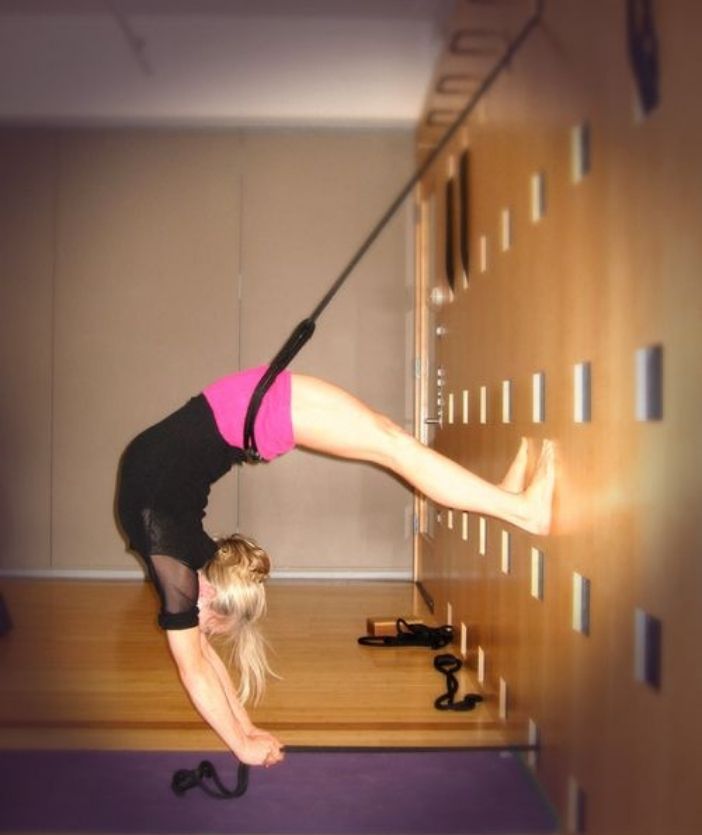
Wheel pose (chakrasana) is another backbend of the Iyengar yoga rope wall poses. It allows a deeper backbend and increases mobility.
This is practiced stepping into the wall holding the rope and bending the knees pressing the feet against the floor. This is followed by lowering the head towards the floor and reaching the floor with the palms arching the back and neck.
It improves the spinal flexibility and strengthen the shoulders while opening the chest. With the rope, it is easily accessed by beginners as well to get toned muscles.
How to do
- Stand facing the wall and securing the loop of the yoga rope around the hips.
- Lean backward and step your feet on the wall.
- Hold the rope with the hands opening the chest lengthen the spine and drop the head backward.
- Release the rope from hands extending the arms to the hamstrings.
- Deepen the back bend by lowering the arms and reaching the floor with the hands arching the back and neck to look towards the fingertips.
- Release by lifting the hands and grabbing the rope and stepping the feet on the floor to stand erect.
9. Extended Side Angle Rope wall pose
It is practiced by standing and stepping the leg near the wall into the rope loop until the loop gets secure around the hip crease. Then, bending the other leg at knee with corresponding palm reaching the floor and extending the arm near wall over head passing through the ear.
Extended side angle pose in rope wall stretches the legs and strengthens the knee and arms. Besides this, it stretches the back, neck, hamstrings, and pelvic region. Also, it enhances the stamina of the practitioner.
How to do
- Stand with the outer edge of your right leg pressed against the wall.
- Step your right leg into the loop created by combining the two yoga ropes suspended on the wall.
- Standing as such walk towards the left until the loop is secured around the right hip crease with feet separated wide apart.
- Open your arms to the sides at shoulder level.
- Turn your left foot 90 degrees to the left and bend your left knee.
- Bend the left side of your trunk over the bent left leg lowering the left palm to the floor beside the left feet.
- Extend the right arm over the head passing through the right ear.
10. Upward facing intense Rope wall stretch
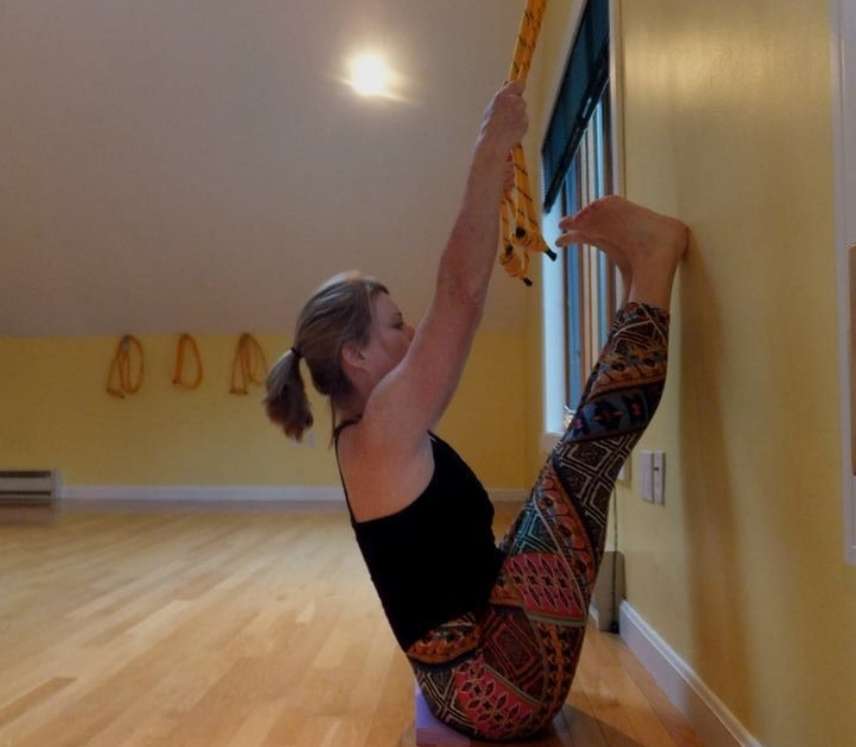
It is practiced sitting on the floor with legs extended against the wall while the arms are extended to hold the ropes overhead with hands. The back is then stretched to lean towards the legs and touch the forehead to the shins.
Practicing upward facing intense west stretch in rope yoga intensely stretches the hamstrings, ankles, and back muscles. It also contracts the abdominal, pelvic, and quad muscles. It is great to burn calories and stimulate sacral chakra.
How to do
- Sit near a wall holding the suspended rope loops with the hands over head.
- Pulling the ropes raise your legs such that the heels are pressed against up against the wall with toes pointing towards you.
- Scoot your buttocks closer to the wall straightening the legs on the wall.
- Keeping the back erect lean forward to touch the forehead to the shins and arms remain extended to hold the ropes with the hands.
- Stay here as long as comfortably possibly breathing gently.
11. Inverted child pose on rope wall
Inverted child pose in rope yoga is assumed by stepping into the wall securing the waist with the rope. This is followed by bending the knee and sliding the shins to the wall while inverted the head towards the floor and lowering the buttocks over the heels.
It brings a sense of relaxation and calmness. You can place a bolster on the floor below the head to relax the neck muscles. It improves blood flow to the brain, stimulates the digestive system, and strengthen the legs and arms.
How to do
- Stand with back towards the wall and taking the suspended rope in front of your waist.
- Securing the rope around the waist, bend your torso forward holding the ropes with the hands.
- Lift your feet and slid them on the wall to bring the shins and top of the feet to the wall.
- Push your buttocks backwards placing them over the heels.
- Lower your head towards the floor and release the arms from the rope placing the palms on the floor.
- Stay there for a couple of breaths and then release bringing your arms to the rope, raising the torso, and stepping back to the floor.
12. Revolved half moon rope wall pose
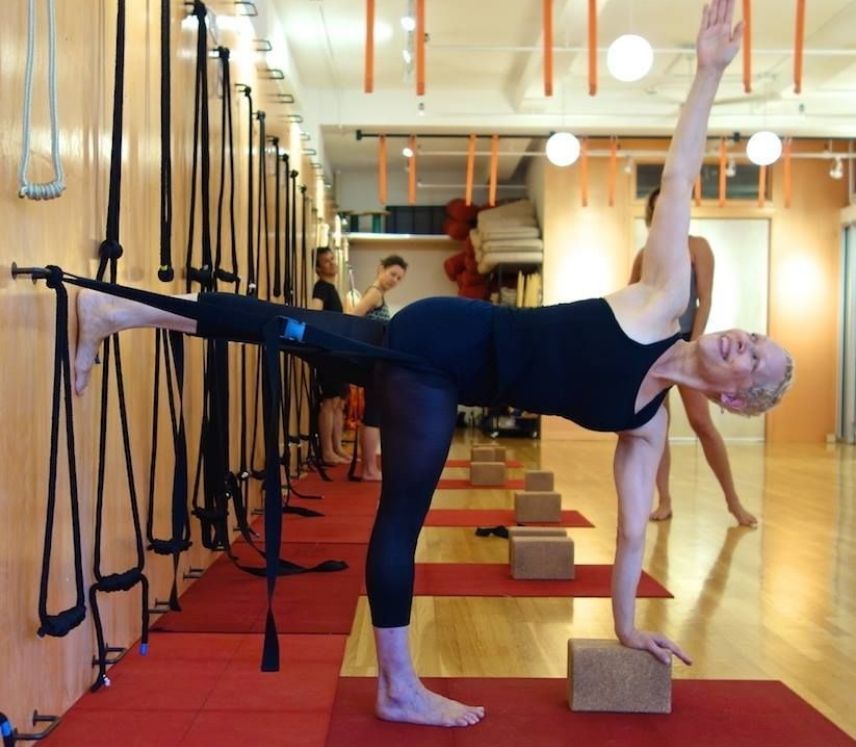
To get into this pose stand keeping one foot on the floor and the other on the wall keeping the legs perpendicular to each other. Holding the rope on the wall bending the torso sideways over the standing leg bringing the corresponding arm to the floor. This is finally completed by releasing the other hand from the rope and extending it to point the fingers to the ceiling.
The rope and wall makes it an easier stretch for the legs, arms, and opens the groins. The spine is also elongated stretching the neck and opening the shoulders intensely.
How to do
- Stand separating the legs wide-apart such that the outer edge of the right foot is pressed against the wall.
- Spread your arms at the shoulder level with right palm pressed against the wall near the rope.
- Turn your left foot 90 degrees towards the left.
- Hold the rope with the left hand and pulling it towards you bend the torso sideways over the left leg until the left palm touches the floor.
- Lift your right leg off the floor and place the right foot on the wall keeping the right leg perpendicular to the left.
- Opening the chest rotate the torso to the front and look towards the right hand.
- Slowly release the rope from the left hand and extend the arm straight towards the ceiling.
Safety Tips in Rope Wall Yoga
Rope yoga is not as scary as hanging on the ropes against gravity seems, however, to avoid any mishap or injury the following safety tips are recommended.
- Make sure the doors or wall that you are using as your base for rope yoga is strong and reliable enough for it.
- The ropes, attachments, or any hardware used in the setup must be a perfect fit and customized for this purpose.
- Do not overlook the weight limits while choosing the surface for rope yoga where you are going to step into or press any part of your body. Therefore, choosing a sturdy surface is a must.
- It is inevitable to check the equipment before every use.
- Guidance from an expert for installing the setup as well as for practicing is strongly recommended.
Conclusion
Do not let your stiffness or level of practice stop you from getting into advanced poses by choosing rope yoga exercises. Practicing with these aiding props like wall and rope configurations makes yoga exciting, exhilarating, and guarantees enhanced benefits.
Therefore, try every possible pose with this Iyenger method of yoga practice and help your body to get all the benefits.

